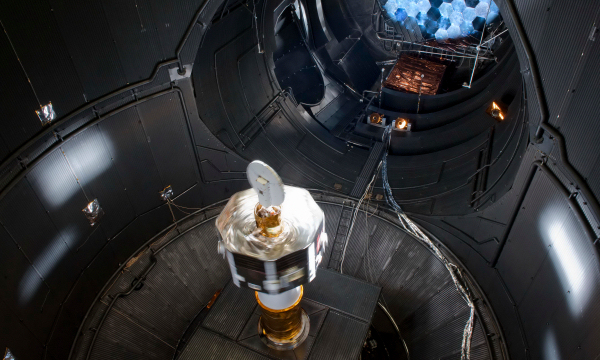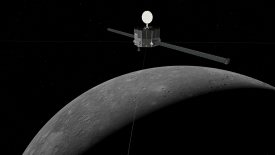Mercury Magnetospheric Orbiter - spacecraft
The Mercury Magnetospheric Orbiter, also referred to as Mio, has been provided by the Institute of Space and Astronautical Science (ISAS) at the Japan Aerospace Exploration Agency (JAXA) and is one of two spacecraft that will orbit Mercury as part of the BepiColombo mission. The other components – the Mercury Planetary Orbiter (MPO); the Mercury Transfer Module (MTM), which carries the two orbiters to their destination; and the Magnetospheric Orbiter Sunshield and Interface Structure (MOSIF), which provides thermal protection and the mechanical and electrical interfaces for Mio – have been provided by ESA. The Mercury Composite Spacecraft (MCS) consists of the MPO, Mio, MTM and MOSIF. ESA has been responsible for the overall mission design, the design, development and test of the MPO, MTM and MOSIF, the integration and test of the MCS and the launch.
Mechanical and thermal design
The primary structure of Mio is an octagonal prism, measuring 1.8 metres between opposing faces and with an overall height of 0.9 metres. Its total mass is around 275 kg, of which the instruments make up about 45 kg. A circular central core carries the separation interface at one end and supports the pylon for the high-gain antenna at the other. The 'top' and 'bottom' panels are recessed within the octagonal outer body; instruments and spacecraft subsystems mounted on the exterior of the top and bottom panels are shielded from the Sun by the walls of the octagon. Each of the eight side panels is fitted with solar cells; the aggregate power generation capacity will be ~350 W during operations at Mercury. The area of the panels not covered by solar cells has a mirror finish to reflect solar radiation.
 |
| A test model of the Mercury Magnetospheric Orbiter in the Large Space Simulator in ESTEC, the Netherlands. Credit: ESA/Anneke Le Floc'h |
Mio will be spin stabilised, with a rotation rate of 15 RPM and a spin axis almost perpendicular to the orbital plane of Mercury around the Sun. This choice of spin axis ensures that the top and bottom of the spacecraft are never Sun-pointed, and enables Earth-pointing of the high-gain antenna with only one degree of freedom mechanism. The centrifugal effect of the spin will enable the deployment of four 15-metre-long wire antennas for electric field and radio wave measurements. The orbiter will also be equipped with two five-metre-long masts to provide a suitable environment for magnetic field measurements, clear of the influence of the spacecraft structure and electrical equipment.
Mio will travel around Mercury in a polar orbit with a period of approximately 9.3 hours, a perihermion (periapsis) of 590 km and an apohermion (apoapsis) of 11 640 km. The orbit will be coplanar with that of the MPO, which will have an orbital period of around 2.3 hours.
Launch, cruise and arrival at Mercury
For launch and the journey to Mercury, the MMO is carried with the MPO as part of the MCS.
During interplanetary cruise, Mio is dormant, with the exception of periodic checkouts. The MPO spacecraft commands Mio and MTM and communicates with Earth. The MTM supplies electrical power for its passengers, as well as for its electric propulsion system.
Shortly before Mercury orbit insertion, the MTM is jettisoned from the spacecraft stack. The MPO then provides Mio with the necessary resources and services until it is delivered into its mission orbit, when control is assumed by JAXA.
Mio is equipped with a 0.8-metre high-gain antenna, which will communicate with the JAXA/ISAS Sagamihara Space Operations Center via the Usuda Deep Space Center (UDSC) 64-metre antenna in Nagano, Japan. A medium-gain antenna is available for backup communications.





